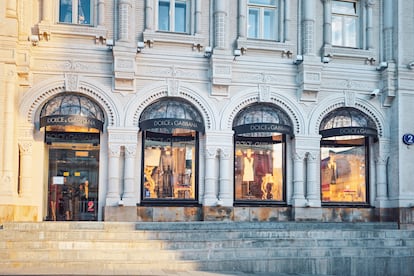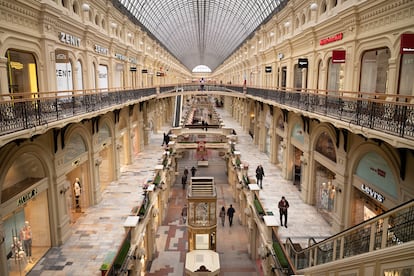It’s not just oil, aircraft, or dual-use products. The series of sanctions against Russia approved by the EU, US and UK also included (and included ). , watches and jewelry. A product that should not have come into the Eurasian giant since the beginning of the invasion of Ukraine. That’s the theory. However, reality takes a different path. Almost three years later, the richest still lack nothing.
Hermès and LVMH stores in Moscow were among the first to close at the start of the war, before mass consumption began. Soon after, Maybach and Rolls-Royce dealers followed suit, leaving a minority with no access to their whims, with 55% of Russian workers earning less than $600 a month and 9 out of 10 earning less than $1,000 a month. remained in It’s for a short period of time.
Since then, there has been a constant influx of luxury products from neighboring countries under the table. The latest international customs data points in this direction, recognizing strong (virtually vertical) growth in imports from countries such as Georgia and Kazakhstan. This is an increase that cannot be explained by the consumption trends of these countries and is an important sign of their participation in triangulation. This allows these selected products to reach their true final destination – Russia.
“There is strong circumstantial evidence that goods from Western countries reach Russia via the Caucasus and Central Asia. This is reflected in mirror trade data for the EU and other countries,” says the German Council on Foreign Relations. expert Benjamin Hilgenstock points out. “Producers of these products do not adequately monitor their distribution networks and do not have sufficient incentives to do so,” he said in an emailed response. “Western governments know what’s going on; cracking down on[reexports]is simply a matter of political will,” wrote Robin Brooks, a researcher at the Brookings Institution.
The EU has banned exports of jewelery and cars worth more than 50,000 euros to Russia for almost two years. However, alternative means to get them to their destination soon appeared. The first was Türkiye, which was also a transit country. This route soon gave way to Belarus, and the government clearly aligned itself with Moscow. Last summer, the EU tried to bridge the gap with a new sanctions package to stop Minsk’s apparent evasion. How successful this will be remains to be seen.
But the biggest holes are currently in the south, in Georgia, Azerbaijan and Kazakhstan. A recent journalistic investigation by the Georgian portal “iFact” does not hesitate to describe the border with Russia as a “paradise for car traffic”, pointing to the imposing mountains of the Caucasus Mountains, the natural border between the two countries. Porsche and Lamborghini are rapidly increasing.

It’s a well-oiled machine. Russian buyers put their trust in the transport company, which is central to the process of registering and insuring the vehicle in their name outside Georgia. Once through the Ras Pass, the only mountain pass from Georgia and the focus of iFact’s research, it will be handed over to its Russian counterpart. Then it’s back to Georgia and back to square one.
The car would have to travel another 1,800 kilometers (1,118 miles) to Moscow and 2,500 kilometers (1,553 miles) to St. Petersburg, the city where almost all of Russia’s wealthy people live. In the process, rubles, laris (Georgia’s official currency), euros and dollars flow in for intermediaries, transport companies and other parties involved in high-profit transfers. In short, Ukraine is a gray market with many winners and one clear loser.
More than 100,000 Russians have fled mobilization and settled in Georgia, not necessarily out of opposition to Vladimir Putin’s government, but simply out of fear of being sent to the front lines in Ukraine. “In the past two years, Russians have opened more companies in Georgia than in the entire past 30 years,” complains one Georgian opposition lawmaker. And some of these companies hold the key to this deal, iFact research says.
Officially, there is no vehicle trade between Georgia and Russia. Tbilisi’s government does not have bilateral sanctions against Moscow, but last year it explicitly banned re-exporting cars to neighboring countries. “We do not want Georgia to be used to evade sanctions against Russia,” Nikoloz Samkharadze said. Parliamentary Foreign Affairs Committee told EL PAÍS. Samharadze’s party, which has been in power since 2012, has been accused of increasing ties to Moscow. When asked about vehicular traffic on the Raas Pass, the politician replied:
– Those cars are made in Armenia.
– But everyone knows that they are not actually Armenian vehicles.
– Well, the car has arrived at customs and has official Armenian documents. Nothing can stop people from traveling to Russia from Armenia.
Therefore, this transaction is not recorded in official statistics. However, data from the Office for National Statistics shows a significant increase in car exports from Georgia, which does not produce cars. From 2012 to 2021, this Caucasian country exported an average of 50,000 cars a year, but in 2022 it exported almost 80,000 cars and last year it exported 108,000 cars. As for profits, their profits are skyrocketing. If this re-export market previously brought Georgia about 400 million euros ($432.7 million) annually, it now exceeds 2 billion euros ($2.16 billion), with a It also shows that prices are rising. Significantly.
Almost all of these exports go to Armenia, Azerbaijan, Kazakhstan, or Kyrgyzstan, which are heavily involved in trade with Russia in banned Western goods. The Georgian government knows this. “These cars are currently being exported from Georgia to Central Asian countries, and these countries then export them to Russia,” Samkaradze says with a shrug. “So it’s not our fault.”

smuggling of luxury goods
According to a study by Otkrytiye Bank and Avtomarketolog channel, smuggling accounts for only 8% of imported cars, the majority of which is accounted for by luxury cars. Just look at the prices on sales portals and you will see that cars in the low or mid-range price range are not worth the money. The most popular models are European luxury cars and Chinese luxury models such as Lixiang and Zeekr.
There are basically two options for obtaining a smuggled car. The easiest way is to go to a dealer who can afford to import a large number of vehicles. On the other hand, if you need a specific model, the most effective option is to turn to an intermediary with contacts in Europe.
“The scheme is simple: someone helps buy the car and transport it to the border, someone registers the car at customs, someone drives the car, and someone takes part in the registration,” says the website for buying and selling imported cars. Avto.ru explains. But direct imports from Europe via Belarus have become more complicated since the middle of this year, said Avtrevizoro, another intermediary. reason? Authorities in Poland and Lithuania are now requesting more documents and “may hold the vehicle for several days.”
phone and sweater
A group of Russian tourists from other regions pose for photos next to the central fountain of the historic GUM shopping center next to Moscow’s iconic Red Square. Upstairs, on the second floor, is a Lacoste store, with labels displaying additional costs to avoid sanctions. A $170 cotton jumper sells in Russia for 20,000 rubles, $32 to $43 more. Official stores of European and American brands such as Karl Lagerfeld, Hugo Boss, Dolce & Gabbana and Dior also remain open in Gum.
Recently, parallel imports have been rapidly increasing. This means, for example, that mobile phone prices are considerably higher than in other parts of the world. At GUM, Samsung sells the 256 GB Galaxy Z for 189,990 rubles, or about $1,940. This is $755 more expensive than, for example, Spain. “Official service will repair your mobile phone in about 300 centers located in Russia and abroad. Also, if you bring us another mobile phone, we will give you a discount on the purchase of a new mobile phone. ” claims one of the salesmen.
There are still products of brands that have completely abandoned Russia. Apple’s new iPhone 16 went on sale here days before its official launch, despite the US tech giant suspending operations in the country. “While we guarantee repairs at our own centers, this phone does not have an official Apple warranty. As you know, it is a parallel import product,” said the California company, which now occupies the former location. A salesman at Re:Store, a Russian chain store, puts it mildly.

Re:Store is not so timid on its official website: “In the near future, many companies will resort to parallel imports of foreign products,” the Russian company predicts. The Constitutional Court banned smuggling in 2018, but at the start of the war the Kremlin legalized it to avoid sanctions.
“Parallel import does not legalize counterfeit goods, we are only talking about the delivery of genuine goods. If a retailer attempts to introduce counterfeit goods into the country, this is considered a serious violation of the law,” Re :Store wrote, along with a sketch justifying the hack, which followed a very simple scheme in which the factory sold phones to third countries. and re-export it to Russia.
The effectiveness of sanctions is questionable
Luxury goods are only part of Russia’s list of G7 sanctions avoidance. Far from the economic collapse many expected in the early stages of the invasion, Russia’s GDP survived the situation better than expected. After falling 1.2% in 2022, it rebounded 3.6% last year and is on track to record similar growth this year. According to the latest forecasts of the International Monetary Fund (IMF). The driving force, of course, was runaway military spending, overshadowed by damage to other important constants. “Increased demand from the military industry is supporting the economy,” Maxim Mironov, a professor at IE Business School and author of several studies on sanctions, told EL PAÍS by phone. “However, GDP no longer represents the economic reality of this country. Families’ spending capacity has been significantly reduced.”
Mironov went on to say that sanctions “affected the economy, but were not enough to stop the war. Russia has far fewer Western products and their prices are soaring, so the biggest losers are People, families.Poverty has increased, but Putin’s ability to spend on war has not.”His conclusion is clear. “Restrictions are not enough, and above all they need to be designed better.” The EU is seeking to close the loopholes that still exist, especially those that allow vital supplies to reach the Kremlin via China. It is currently considering economic retaliation against Russia. Crack another can of worms.
Sign up for our weekly newsletter and get more English news coverage from EL PAÍS USA Edition



